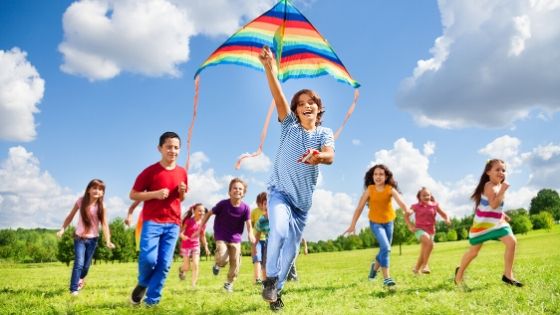Everyone who has seen kids on a playground knows that most are physically involved naturally, and love to run around. But what might not be obvious is that jumping to the top of a slide or hanging from the monkey bars will help to keep children healthy for life. As they get older, getting enough daily activity can be a challenge for the children. That may be because of:
- A feeling amongst some children that sports are not good
- Lacking the positive role models
- Increasing School demands
- Families busy with work
And even though children have enough time & ability to be involved, Family can’t feel it confident allowing them to wander neighbourhood freely, just as children did generations ago. So, their chances of becoming involved can be limited.
Given these challenges, parents should encourage a passion and support of physical activity & help children incorporate it within their daily lives. Do so will create healthy habits to last through ‘Adulthood’.
Benefits of Being Active
Once children are involved Their bodies can do whatever they want to do, and they need to do them. Why? For what? Since daily exercising brings benefits such as:

- Muscles and bones solid
- Total weight
- Increased chance of type 2 diabetes;
- To sleep easier
- Better Life outlook
In school, too, physically fit children have a greater chance of being inspired, centered and successful. Learning physical abilities develops confidence at all ages.
What Motivates Children?
There seems to be a lot of learning from everyday physical exercise but how would you inspire children to do the same? The three steps to doing so is:
- Select the best activities for your child: The child can be bored or irritated if you don’t.
- Giving children lots of good opportunities to engage: Young kids want family members to support their participation by supplying facilities, signing up for classes or sports teams, & take them to sports fields, and some other involved locations.
- Holding the emphasis on fun: Children don’t do something they don’t want.
Because once children love an activity, they really want to do more. Trying to practice a Abilities — whether diving or driving a motor bike — enhance their skills and makes them feel accomplished, Particularly if they notice and appreciate the effort. Such positive feelings also make children want to carry on the activity and even seek out others.
Activities suited to Age
The easiest way to really get regular activity for kids is by implement physical exercise in to the everyday schedule. Pre-schoolers & Toddlers are expected to play active several times a day. The Sixty minutes of physical activity will be performed by children’s ages 6 to 17 or more per day. It can include free home play, effective time in school, and engagement in classes or sports events.
Advice based on Age – Pre-schoolers
Pre-schoolers need to practice & try exercising which enables them keep going improve vital cognitive abilities — Exercise to help them continue to kick or throw a ball, play contests or chase the leader, trying to jump with one foot, riding a bicycle or a road bike with wheel chocks or doing assault course.
While children as young as 5 may have certain sporting tournaments available, competitive sports by team really aren’t advised until they are a little older than that. Preschool children are incapable of understanding complicated processes, & sometimes lack the knowledge, skills & teamwork required to play sports. They can work on basic fundamentals, instead of playing on a team.
Advice based on Age – School-age
As school-age children spend lots of time beside the screens, Parents are motivated to support kids seek those fitness activities they enjoy, and to make them feel effective. This may range from typical sports such as football and basketball to combat sports, surfing, climbing, & outdoor play. When children learn fundamental skills and common laws even in initial school-age years, about a handful athlete standouts may be present. When children grow older, variations in ability and temperament are becoming more apparent. Dedication and level of interest always seem to go hand in hand with capacity, and that’s why finding an activity which is ideal for your children is important. During these years, schedules start to get busy but wouldn’t hesitate to keep off enough time for playing games.
Advice based on Age – Teenagers
Teenagers have plenty of options when it comes to being competitive — including school activities to after-school activities like exercise or bike riding. Making an activity schedule is a smart idea, as it always needs to be wedged between Home-to-school obligations.
Do as much as you can to get your teenager exercising easier by offering mobility & the appropriate equipment (including workout gear). The right shoes and clothes may in some cases support a scared teenager to feel safe cycling or working out in the gym.
The Physical Personalities of Kids
In relation to a person’s age, consideration of his or her personality of fitness is important. Characteristics of personality, biology and physical strength combine to shape the attitudes of children towards sports activity and various bodily movements, especially as they become older.
What of the 3 kinds shows up your children perfectly?
- The Non-Sporty: A individual can lack physical strength, An Athletic exercise desire, or even both.
- The Passive Athlete: This individual is keen in becoming active but is not a top prospect and in a competitive sporting atmosphere is at risk of being discouraged.
- The Sportsman: Any such kid does have athleticism, is dedicated to a activity or sports, which is likely to dramatically increase competitive duration for practice and strength.
When people understand the principles of the types of Fitness & Temperament, you will be delighted to support your children to pick the appropriate activity and have enough physical exercise & appreciate the physical activity. Lots of kids would like to achieve excellence in athletics while others like casual players can be perfectly happy and healthy.
For example, the athlete might like to be with hockey or basketball team, whereas the non-athlete will simply have fun shooting hoops in the park or on the street. The casual athlete would definitely require the support and motivation of a parent to get physically fit and remain active. This is why motivating children to stay involved even though they aren’t best performers is crucial.
Whatever the nature of their parents, all the children should be physically fit. Positive outlook from a parent will support a child who is unwilling to work out or involve in physical exercise.
Be responsible & encourage passions of your children. When you begin it early on, they will come to accept activity as a natural & exciting part of daily routine of your family.








